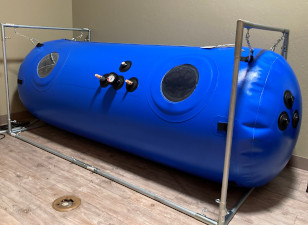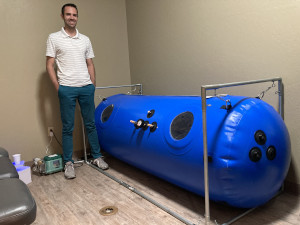
Chiropractor Chandler AZ
Hyperbaric Oxygen Therapy for Traumatic Brain Injury
Traumatic brain injury (TBI) is on the rise in the United States, due in part to more diligence in evaluating concussions from team sports injuries. Estimates of 4.8 million cases of TBI in the US annually (Harch et al.,2020) indicate most cases are considered mild TBI. That being said, symptoms that persist three years or longer indicate that the syndrome may be permanent (Harch et al., 2020).
In addition to mortality and severe cognitive impairment, traumatic brain injuries can also lead to affective disorders such as anxiety and depression, having a significant impact on quality of life (Harch et al., 2020). As a result, scientists have been searching for effective, non-invasive therapies that can substitute for more invasive procedures such as neural transplantation (Rolfe & Sun, 2015). To date a number of human and animal studies have been conducted that support the efficacy of hyperbaric oxygen therapy (HBOT) for treatment of TBI, with the strongest evidence for moderate-to-severe cases.
What is hyperbaric oxygen therapy?
Hyperbaric oxygen therapy (HBOT) involves the use of a pressurized chamber to deliver pure oxygen to patients with conditions such as carbon monoxide poisoning, decompression sickness, necrotic tissue injury and ischemic brain injury. Ischemia refers to a lack of oxygen to the brain that can occur as the result of stroke or TBI. Brain cells (neurons and glia) depend heavily on oxygen for survival, primarily due to the way the brain metabolizes energy. The idea behind HBOT is to deliver oxygen-enriched blood plasma to the brain so it can heal.

There are two types of hyperbaric chambers: multiplace chambers that hold up to eight individuals and an overseer, most often found in tertiary facilities such as hospitals, and monoplace chambers that hold a single individual more commonly seen in outpatient clinics (Schaefer, 1992). At the beginning of the treatment, the chamber is pressurized above sea level atmosphere (1ATA), to 1.3-3.0 ATA. While in the chamber, the patient breathes pure oxygen, which is approximately five times richer than what is found in the atmosphere (Deng et al., 2018). As a result, enough oxygen diffuses into the blood plasma that the body no longer needs to depend on the oxygen bound to hemoglobin, which facilitates oxygen delivery to injured tissues (Tibbles & Edelsberg, 1996).
Although some patients may experience side effects such as pressure in the middle ear or sinuses, transient myopia and in some cases, chest pain, these effects are generally mild and the treatment is well tolerated. HBOT is considered safe and effective for treatments lasting up to two hours at atmospheric pressures up to 3 ATA (Tibbles & Edelsberg, 1996).
How does HBOT work to improve symptoms of TBI?
As mentioned earlier, ischemia or oxygen deprivation is one of the most concerning consequences of traumatic brain injury, because it leads to rapid cell death. Fortunately, oxygen can easily cross the blood brain barrier (BBB), so oxygen delivered through inhalation can easily reach the brain.
Animal studies have shown that HBOT functions by transferring mitochondria from astrocytes (a type of glia) to neurons, to improve oxidative metabolism following TBI (Gonzales-Portillo et al., 2019). Mitochondria are small organelles (parts of a cell) that serve as the “powerhouse:” they metabolize blood sugar to form adenosine triphosphate (ATP) that the body can use as energy. Think of neurons as the workhorses of the brain with astrocytes as the supporting cast. Because neurons are the only cells in the brain that transmit electrical signals, it is particularly important that they receive enough energy to do their job. By transferring mitochondria from the astrocytes to damaged neurons in an oxygen-enriched atmosphere, the neurons can metabolize glucose aerobically in order to restore function (Gonzales-Portillo et al., 2019).

Studies on human subjects confirm the efficacy of HBOT for symptom reduction in TBI, particularly for moderate-to-severe cases. A randomized controlled trial evaluated the effect of HBOT on military and civilian subjects ages 18-65 with TBI using a case control design Harch et al., 2020). In this type of study, each group of subjects receives the treatment and then serves as its own “control,” by comparing results after treatment with results from no treatment. All subjects met the diagnostic criteria for persistent post-concussive syndrome (PPCS), meaning they had continued to experience symptoms for at least three years following the trauma. Primary outcomes were a neurobehavioral symptom inventory (NSI) and working memory. In both groups, patients undergoing treatment experienced a 19% relative decrease in symptoms compared to controls, which is statistically and clinically significant (Harch et al., 2020). Differences in working memory were not considered significant (Harch et al., 2020).
A systematic review and meta-analysis of 25 studies on human subjects compared the effects of hyperbaric oxygen therapy to normobaric oxygen therapy (oxygen delivery at normal atmospheric pressures) and no treatment in individuals with TBI (Deng et al., 2018). Patients included those who had suffered ischemic strokes and concussions. Researchers found strong evidence for use of normobaric oxygen therapy (NOT) for stroke patients, while those with concussive TBI, particularly of moderate to severe nature, experienced better outcomes with HBOT (Deng et al., 2018). According to study authors, hyperbaric oxygen therapy significantly improved Glasgow Outcome Scores- a standard measure of post-TBI function- and reduced overall mortality in patients with severe TBI. They endorsed the use of HBOT for improving metabolism in the brain, oxygen, intracranial pressure and quality of life (Deng et al., 2018).
Treatment Protocol
A typical treatment takes about 90 minutes, including 15 minutes to pressurize and another 15 to depressurize before and after treatment. Because some individuals can experience pressure build-up in the ears, it is recommended that patients know how to clear their ears, similar to what one would do on an airplane during take-off and landing. Patients should also notify the provider of any claustrophobic concerns, so they can be taught relaxation techniques prior to the session (Schaefer, 1992).
The machine makes some noise, but most patients feel comfortable reading and relaxing inside the chamber. An intercom system enables the patient to communicate with the provider during therapy.
References
Deng, Z. et al. (2018). The neuroprotection effect of oxygen therapy: a systematic reivew and meta-analysis. Nigerian Journal of Clinical Practice, 21, 401-416. https://doi.org/10.4103/njcp.njcp_315_16
Gonzales-Portillo, B. et al. (2019). Hyperbaric oxygen therapy: a new look on treating stroke and traumatic brain injury. Brain Circulation, 5(3), 101-105. https://doi.org/10.4103/bc.bc_31_19
Harch, P. et al. (2020). Hyperbaric oxygen therapy for mild traumatic brain injury persistent postconcussion syndrome: a randomized controlled trial. Medical Gas Research, 10(1), 8-20. http://www.medgasres.com
Rolfe, A. & Sun, D. (2015). Stem cell therapy in brain trauma: implications for repair and regeneration in experimental TBI models. In FH Kobeissy (Ed.). Brain Neurotrauma: Molecular, Neuropsychological and Rehabilitation Aspects, (Chapter 42). CRC Press/Taylor & Francis.
Schaefer, S. (1992). Fundamentals of hyperbaric oxygen therapy. Orthopaedic Nursing, 11(6), 9-15.
Tibbles, P. & Edelsberg, J. (1996). Hyperbaric oxygen therapy. New England Journal of Medicine, 334(5), 1642-1648.